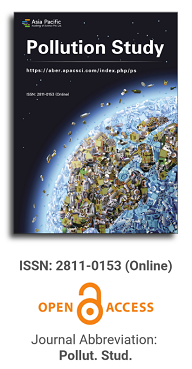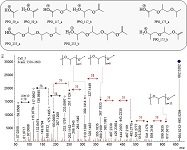
Asia Pacific Academy of Science Pte. Ltd. (APACSCI) specializes in international journal publishing. APACSCI adopts the open access publishing model and provides an important communication bridge for academic groups whose interest fields include engineering, technology, medicine, computer, mathematics, agriculture and forestry, and environment.

The (partial) replacement of synthetic polymers with bioplastics is due to increased production of conventional packaging plastics causing for severe environmental pollution with plastics waste. The bioplastics, however, represent complex mixtures of known and unknown (bio)polymers, fillers, plasticizers, stabilizers, flame retardant, pigments, antioxidants, hydrophobic polymers such as poly(lactic acid), polyethylene, polyesters, glycol, or poly(butylene succinate), and little is known of their chemical safety for both the environment and the human health. Polymerization reactions of bioplastics can produce no intentionally added chemicals to the bulk material, which could be toxic, as well. When polymers are used to food packing, then the latter chemicals could also migrate from the polymer to food. This fact compromises the safety for consumers, as well. The scarce data on chemical safety of bioplastics makes a gap in knowledge of their toxicity to humans and environment. Thus, development of exact analytical protocols for determining chemicals of bioplastics in environmental and food samples as well as packing polymers can only provide warrant for reliable conclusive evidence of their safety for both the human health and the environment. The task is compulsory according to legislation Directives valid to environmental protection, food control, and assessment of the risk to human health. The quantitative and structural determination of analytes is primary research task of analysis of polymers. The methods of mass spectrometry are fruitfully used for these purposes. Methodological development of exact analytical mass spectrometric tools for reliable structural analysis of bioplastics only guarantees their safety, efficacy, and quality to both humans and environment. This study, first, highlights innovative stochastic dynamics equations processing exactly mass spectrometric measurands and, thus, producing exact analyte quantification and 3D molecular and electronic structural analyses. There are determined synthetic polymers such as poly(ethylenglycol), poly(propylene glycol), and polyisoprene as well as biopolymers in bags for foodstuffs made from renewable cellulose and starch, and containing, in total within the 20,416–17,495 chemicals per sample of the composite biopolymers. Advantages of complementary employment in mass spectrometric methods and Fourier transform infrared spectroscopy is highlighted. The study utilizes ultra-high resolution electrospray ionization mass spectrometric and Fourier transform infrared spectroscopic data on biodegradable plastics bags for foodstuffs; high accuracy quantum chemical static methods, molecular dynamics; and chemometrics. There is achieved method performance |r| = 0.99981 determining poly(propylene glycol) in bag for foodstuff containing 20,416 species and using stochastic dynamics mass spectrometric formulas. The results highlight their great capability and applicability to the analytical science as well as relevance to both the fundamental research and to the industry.
Cellulosic nanomaterials for adsorption of emerging pollutants
Vol 5, Issue 1, 2024
Download PDF
Abstract
Context: At present, nanotechnology can be used in multiple areas of action which, due to its nature, can be implemented with great versatility, given that many advances in nanotechnology base their studies on how to optimize daily and industrial processes and how to favor the environment. In addition, the manipulation of matter at this level allows the creation of solutions with greater scientific, social and economic impact. For the purposes of this research, laboratory results will be shown using cellulosic nanomaterials for the adsorption of emerging antibiotic-type contaminants. Method: This research was carried out at laboratory level, where cellulose was modified by chemical methods to obtain nanocellulose by oxidation. A characterization of the material obtained by spectroscopy techniques was carried out, and the adsorption of emerging anti-biotic contaminants such as ciprofloxacin. Results: Cellulosic nanomaterials have the potential to be used in tertiary water treatment for the removal of emerging contaminants such as ciprofloxacin. The results show that the cellulosic nanomaterial adsorbs ciprofloxacin by 27%. Conclusions: Nanocellulose membranes have potential for use in a water purification system; those made only with cellulose showed a lower percentage of contaminant adsorption than membranes with nanocellulose.
Keywords
References
- González G, Retamoza JG, Álborez Arazate H, Guerrero de León A. Integrated watershed management: an alternative to the sustainability of water resources in Mexico. Lacan- donia, 2016; 10(1): 91-98.
- Scholz M. Water Treatment. Wetlands for Water Pollution Control. 2016: 9-11. doi: 10.1016/b978-0-444-63607-2.00002-2
- Gautam RK, Chattopadhyaya MC. Chap-ter 1. Nanotechnology for Water Cleanup. In: Gautam RK, Chattopadhyaya MC (editors). Nanoma-terials for Wastewater Remediation. Boston: Butterworth-Heinemann; 2016.
- Suárez F, García A, Vaca L. Identification and evaluation of water pollution by tanneries in the municipality of Villapinzón. Tecnu- ra. 2012; 16(1): 185-194.
- Olvera RC, Silva SL, Robles-Belmont E, et al. Review of nanotechnology value chain for water treatment applications in Mexico. Resource-Efficient Technologies. 2017; 3(1): 1-11. doi: 10.1016/j.reffit.2017.01.008
- León A, Córdoba JC, Carreño UF. Review of the state of the art in rainwater harvesting and harvesting in urban areas and airports. Tecnura. 2016; 20(50): 141-153.
- Qu X, Alvarez PJJ, Li Q. Applications of nanotechnology in water and wastewater treatment. Water Research. 2013; 47(12): 3931-3946. doi: 10.1016/j.watres.2012.09.058
- Adeleye AS, Conway J, Garner K, et al. Engineered nanomaterials for water treatment and remediation: Costs, benefits, and applicability. Chemical Engineering Journal 2016; 286(4): 640-662. doi:10.1016/j.cej.2015.10.105
- Lin N, Bruzzese C, Dufresne A. TEMPO-Oxidized Nanocellulose Participating as Crosslinking Aid for Alginate-Based Sponges. ACS Applied Materials & Interfaces. 2012; 4(9): 4948-4959. doi: 10.1021/am301325r
- Abdul Khalil HPS, Davoudpour Y, Islam MN, et al. Production and modification of na- nofibrillated cellulose using various mechanical processes: A review. Carbohydrate polymers. 2014; 649-665. doi: 10.1016Zj. carbpol.2013.08.069.
- Garcia-Alonso JA, Zurita-Martinez F, Guzmán-González CA, et al. Nanostructured diatomite and its potential for the removal of an antibiotic from water. Bioinspired, Biomimetic and Nanobiomaterials. 2018; 7(3): 167-173. doi: 10.1680/jbibn.18.00020
- Rostamian R, Behnejad H. A compre-hensive adsorption study and modeling of anti-biotics as a pharmaceutical waste by graphene oxide nanosheets. Ecotoxicology and Environmen-tal Safety. 2018; 147, 1 17-123.
- Thakkar M, Wu Z, Wei L, et al. Water defluoridation using a nanostructured diatom–ZrO2 composite synthesized from algal Biomass. Journal of Colloid and Interface Science. 2015; 450: 239-245. doi: 10.1016/j.jcis.2015.03.017
Supporting Agencies
Copyright (c) 2024 Belkis Coromoto Sulbarán Rangel, Abigail Eloísa Madrigal Olveira, Víctor Hugo Romero Arellano, Carlos Alberto Guzmán González

This work is licensed under a Creative Commons Attribution 4.0 International License.

This site is licensed under a Creative Commons Attribution 4.0 International License (CC BY 4.0).
.jpg)
Beijing University of Technology, China



